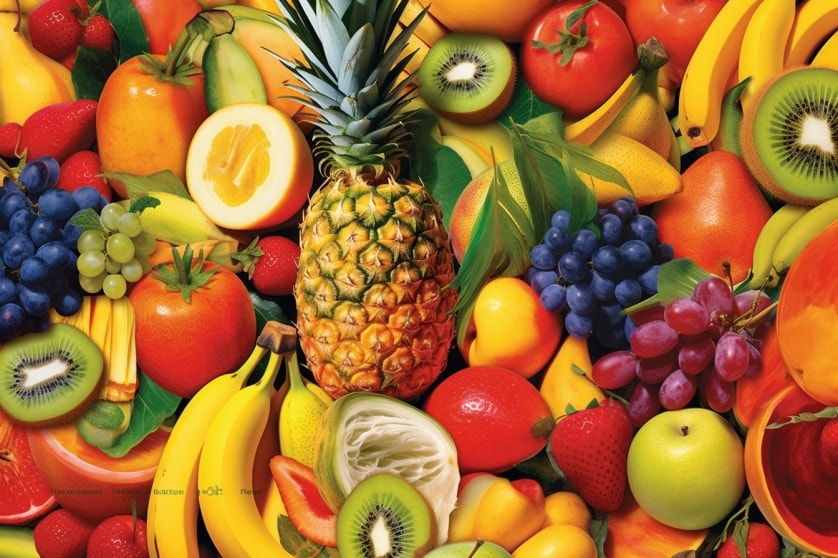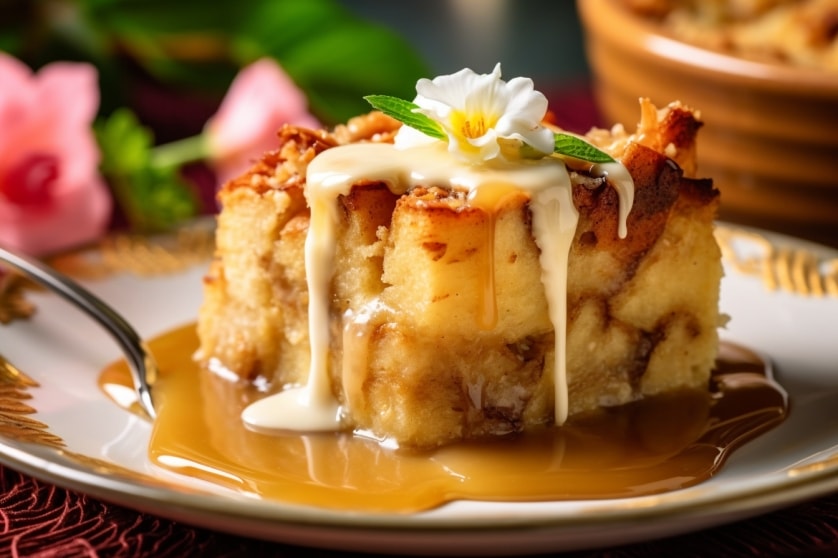Table of Contents
ToggleTropical Paradise: Pineapple Coconut Bread Pudding for Dessert Delight
Introduction:
Picture this: the warm sun kissing your skin, the gentle breeze swaying the palm trees, and the tantalizing aroma of tropical flavors filling the air. Now, imagine sharing that blissful experience with your little one, introducing them to the vibrant and enchanting world of Caribbean cuisine. As a successful woman family care blogger and author with a Caribbean background, I have a secret recipe that will transport you and your baby to a tropical paradise: Pineapple Coconut Bread Pudding!
There’s something truly magical about the flavors of pineapple and coconut. They dance together in perfect harmony, creating a symphony of sweetness and tropical delight. And what better way to indulge in these heavenly flavors than in the form of a decadent bread pudding? But hold on, this isn’t just any ordinary bread pudding; it’s a baby-friendly version that will make both you and your little one squeal with joy!
Now, I know what you might be thinking. Can babies really enjoy such a sophisticated dessert? Absolutely! Introducing your baby to a variety of flavors early on is not only an exciting culinary adventure but also sets the foundation for a diverse palate. Research shows that exposing babies to a wide range of tastes and textures from an early age can help them become more adventurous eaters in the long run. So, why not start their culinary journey with a tropical twist?
But let’s not forget about you, dear parent! As a busy caregiver, you deserve a little taste of paradise too. This recipe allows you to satisfy your sweet tooth while knowing that you’re nourishing your baby with wholesome ingredients. It’s a win-win situation that brings smiles to everyone at the table!
Now, get ready to embark on a delicious adventure as we explore the captivating flavors of pineapple and coconut. From their intriguing origins to their nutritional benefits, we’ll dive into the wonders of these tropical gems. So, grab your apron, put on your culinary cap, and let’s whip up a dessert that will transport your taste buds to a sun-drenched beach in the Caribbean!

Section 1: Exploring the Tropical Gems
Uncovering the Origins
Close your eyes and imagine the sun-drenched shores of the Caribbean, where the scent of ripe pineapples and the sound of cracking coconuts fill the air. These tropical gems have been enchanting taste buds for centuries, and their origins are as fascinating as their flavors.
Pineapple, with its juicy sweetness and vibrant golden hue, hails from the tropical regions of South America. Native to countries like Brazil and Paraguay, this prickly fruit was cherished by the indigenous tribes who believed it possessed magical powers. They called it nanas, which means excellent fruit, and boy, were they right!
Coconut, on the other hand, has a journey as captivating as the waves that crash upon the Caribbean shores. Its story begins in the lush coastal areas of Southeast Asia, where it grew wild and free. Over time, coconuts embarked on a grand adventure, floating across the vast oceans, until they found their new home in the Caribbean. From Jamaica to Barbados, coconuts became an integral part of Caribbean culture and cuisine, lending their creamy goodness to countless dishes.
Cultural Significance and Culinary Delights
In the Caribbean, pineapples and coconuts are not just fruits; they are symbols of joy, hospitality, and celebration. You’ll find them adorning tropical drinks, gracing the tables of festive feasts, and even inspiring traditional dances. Yes, these fruits can make you want to bust a move!
When it comes to Caribbean cuisine, pineapples and coconuts are like the dynamic duo, working together to create culinary masterpieces. Imagine savoring a plate of succulent jerk chicken accompanied by a refreshing pineapple salsa—your taste buds would do a happy dance! And let’s not forget about coconut milk, the creamy elixir that adds a velvety richness to curries, desserts, and even drinks.
One of the most beloved Caribbean desserts is the piña colada, a heavenly concoction of pineapple, coconut cream, and rum. It’s like sipping pure paradise from a frosty glass! And when it comes to satisfying your sweet tooth, pineapple upside-down cake and coconut macaroons are just a taste of the tropical indulgence that awaits.
Tropical Allure and Exotic Appeal
There’s something undeniably captivating about the tropical allure of pineapples and coconuts. The sight of a perfectly ripe pineapple, with its spiky crown and golden flesh, is like a beacon of sunshine, instantly brightening your day. And cracking open a coconut? It’s like unlocking a treasure chest filled with creamy goodness and a hint of the sea.
But it’s not just their enticing appearance that makes pineapples and coconuts so special. These fruits are packed with unique flavors that transport your taste buds to a distant paradise. The juicy sweetness of pineapple dances on your tongue, while the creamy, nutty essence of coconut takes you on a tropical escape with every bite.
It’s no wonder that pineapples and coconuts have become global icons of exotic appeal. From Caribbean beaches to tiki bars around the world, these tropical gems add a touch of vacation bliss to any setting. So, why not bring a taste of the tropics into your kitchen and create a dessert that will transport you and your little one to a sun-kissed paradise?

Section 2: Discover the Tropical Wonders
Delving into Pineapple’s Secrets
Ah, the pineapple—a fruit that’s as intriguing as it is delicious. Did you know that pineapples were considered a status symbol during the 18th century? Yes, you heard that right! In Europe and North America, it was a sign of wealth and hospitality to have a pineapple adorning your dining table. People would even rent pineapples for parties just to show off!
But let’s dive deeper into the secrets of this tropical wonder. Did you know that pineapples are not actually a single fruit but a cluster of berries that fuse together? Mind-blowing, isn’t it? Each eye on the pineapple’s surface represents an individual berry, and together they create that iconic spiky exterior.
Now, let’s talk about the unique enzyme found in pineapples called bromelain. It’s like a hidden superhero, fighting inflammation and aiding digestion. Bromelain has been used for centuries in traditional medicine to treat various ailments, from reducing swelling to soothing indigestion. So, not only does pineapple taste fantastic, but it also comes with a side of health benefits!
Coconut: The Versatile Wonder
Now, let’s turn our attention to the versatile wonder known as the coconut. Did you know that coconuts are not true nuts but actually classified as drupes? Don’t worry if you’ve never heard that term before; it just means they’re a type of fruit with a hard outer layer and a fleshy interior.
But what makes coconuts truly remarkable is their incredible versatility. From the roots to the leaves, every part of the coconut tree has a purpose. People in the Caribbean have mastered the art of utilizing every bit of this remarkable tree, from using the husks for fuel and building materials to crafting beautiful baskets and ornaments.
Now, let’s talk about coconut water—the ultimate thirst quencher. It’s like nature’s sports drink, packed with electrolytes and minerals that hydrate and replenish your body. And the best part? It comes in its own convenient package! Just crack open a fresh coconut and sip away.
But wait, there’s more! Coconut milk, the creamy elixir that adds richness to dishes, is also a nutritional powerhouse. It’s high in healthy fats that provide sustained energy and satiety. So, whether you’re making a curry or a dessert, coconut milk adds a velvety smoothness that will have your taste buds begging for more.
Exotic Species and Rare Delights
Prepare to have your mind blown, because pineapples and coconuts have some exotic and rare varieties that are sure to pique your curiosity. Ever heard of the Red Spanish pineapple? With its vibrant red skin and juicy, tropical flavor, it’s a true showstopper. And let’s not forget the Sugarloaf pineapple—a cone-shaped delight that’s both visually stunning and incredibly sweet.
Now, let’s move on to coconuts. Have you ever heard of the King Coconut? This regal variety is mainly found in Sri Lanka and is prized for its naturally sweet water and tender flesh. It’s like sipping liquid gold from a coconut! And if you’re a fan of coconuts with a pink twist, keep an eye out for the Malayan Dwarf coconut. Its striking pink color and delicate flavor make it a rare treat.
These exotic species and rare delights remind us of the incredible diversity and beauty of nature. They show us that there’s always something new and exciting to discover in the world of tropical fruits. So, the next time you come across a unique pineapple or a rare coconut variety, be sure to savor every moment and let your taste buds embark on a thrilling adventure!

Section 3: From Fresh to Baby-Friendly
Preparing Pineapple for Your Little One
Now that we’ve explored the wonders of pineapples and coconuts, let’s dive into the exciting world of introducing these tropical delights to your little one. When it comes to pineapples, there are a few things to keep in mind to ensure they are baby-friendly and safe for your tiny tot.
First things first, choose a ripe pineapple that is fragrant and has a golden color. This ensures that the fruit is at its peak sweetness, making it more enjoyable for your baby. To prepare the pineapple, start by removing the tough outer skin. Then, slice it into small, bite-sized pieces, removing the core, which can be a bit tough for your baby to handle.
Now, here’s a little trick to make pineapples even more baby-friendly: gently roast or grill the pineapple pieces. This softens the fruit and brings out its natural sweetness, making it easier for your baby to chew and enjoy. Just be sure to let it cool down before serving it to your little one.
It’s worth noting that while pineapples are a delicious addition to your baby’s diet, they can be acidic, so it’s important to introduce them gradually and watch for any signs of tummy discomfort or irritation. Every baby is different, so trust your instincts and consult with your pediatrician if you have any concerns.
Coconuts: Nature’s Creamy Delight
Now, let’s talk about coconuts and how to make them baby-friendly. Coconut is a versatile ingredient that can be introduced to your baby’s diet in various forms, depending on their age and chewing abilities.
If your baby is just starting their solid food journey, you can offer them coconut milk or coconut water. These are great options for hydration and introducing mild coconut flavor. Look for unsweetened and pasteurized versions, as they are the safest and most suitable for your little one.
As your baby grows and develops their chewing skills, you can introduce small pieces of fresh coconut flesh. Make sure the coconut pieces are soft and finely grated to prevent any choking hazards. You can sprinkle a little grated coconut on top of their purees or mix it into their oatmeal or yogurt for added texture and flavor.
For older babies who are more experienced with solid foods, you can offer them coconut-based snacks like coconut flakes or coconut chips. These provide a satisfying crunch and introduce them to different textures.
Remember, it’s always important to closely monitor your baby when introducing new foods, including pineapples and coconuts. Watch for any signs of allergies or digestive issues, and introduce one new food at a time to easily identify any potential reactions.
Benefits of Pineapple and Coconut for Your Baby
Now that we’ve discussed how to prepare pineapples and coconuts for your little one, let’s explore the amazing benefits these tropical fruits offer for their growing bodies.
Pineapples are packed with essential vitamins and minerals. They are a great source of vitamin C, which supports your baby’s immune system and helps with iron absorption. Pineapples also contain manganese, a mineral that plays a vital role in bone development and metabolism. Plus, their natural sweetness can help satisfy your baby’s sweet cravings without added sugars.
Coconuts, on the other hand, offer a plethora of benefits for your baby’s health. Coconut milk is a rich source of healthy fats, which are essential for brain development and overall growth. It provides a creamy texture and adds a delightful flavor to your baby’s meals. Coconut water, on the other hand, is a fantastic hydrating option, especially on hot summer days or during bouts of illness.
Both pineapples and coconuts are also rich in dietary fiber, which aids digestion and helps regulate bowel movements. This can be particularly beneficial if your baby is experiencing constipation or tummy troubles.
So, by introducing pineapples and coconuts into your baby’s diet, you’re not only delighting their taste buds but also nourishing their growing bodies with a host of essential nutrients.

Section 4: Nutritional Powerhouses
The Health Benefits of Pineapple
Get ready to discover the nutritional superpowers of pineapples! These spiky tropical delights are not only a treat for your taste buds but also a treasure trove of health benefits.
First and foremost, pineapples are loaded with vitamin C, which is known for its immune-boosting properties. A single serving of pineapple can provide a significant portion of your baby’s daily vitamin C needs. This mighty vitamin not only helps protect your little one from pesky colds and infections but also supports the development of healthy skin, bones, and connective tissues.
But that’s not all—pineapples also contain bromelain, a powerful enzyme with anti-inflammatory properties. Bromelain can help soothe digestive issues, reduce swelling, and even support post-injury recovery. So, if your little one is teething or experiencing tummy troubles, pineapple can be a natural remedy to the rescue!
Furthermore, pineapples are a great source of dietary fiber, which aids in healthy digestion and helps prevent constipation. It’s like a natural little scrub brush for your baby’s tummy, keeping everything moving smoothly.
And let’s not forget about the antioxidants found in pineapples. These mighty compounds help protect your baby’s cells from damage caused by free radicals and oxidative stress. So, snack on some pineapple slices and let those antioxidants work their magic!
The Marvels of Coconut
Now, let’s turn our attention to the incredible nutritional profile of coconuts. These hairy globes are not just tasty; they’re also nutritional powerhouses that offer an array of health benefits for your little one.
Coconuts are packed with healthy fats, specifically medium-chain triglycerides (MCTs), which are easily absorbed and utilized by the body for energy. These MCTs provide a quick and sustained source of fuel for your baby’s growing body and developing brain. They are like little superheroes, supporting healthy brain function and promoting optimal growth.
But that’s not all—coconuts also contain lauric acid, a fatty acid with antimicrobial and antiviral properties. This means that consuming coconuts can help strengthen your baby’s immune system and protect them from harmful bacteria and viruses.
Coconuts are also rich in minerals such as potassium, magnesium, and manganese. These minerals are essential for healthy bone development, proper nerve function, and maintaining a balanced electrolyte level in the body. So, the next time your baby enjoys some coconut goodness, remember that they’re also getting a dose of these vital minerals.
Another fantastic benefit of coconuts is their low glycemic index (GI). This means that coconut-based foods and beverages provide a slow and steady release of energy, helping to maintain stable blood sugar levels. This can be particularly beneficial for babies with sensitive tummies or those at risk of blood sugar imbalances.
So, whether you’re incorporating pineapple or coconut into your baby’s meals, you’re introducing them to a world of nutritional powerhouses. These tropical gems not only tantalize their taste buds but also nourish their bodies with an array of essential vitamins, minerals, antioxidants, and healthy fats.

Section 5: Indulge in Tropical Delight
Ingredients and Recipe Steps
Are you ready to create a dessert that will transport you and your little one to a tropical paradise? Get your mixing bowls ready because we’re about to whip up a mouthwatering Pineapple Coconut Bread Pudding that will leave everyone craving for more!
Ingredients:
- 2 cups of stale bread, cubed
- 1 cup of fresh pineapple chunks
- 1 cup of coconut milk
- 1/2 cup of unsweetened shredded coconut
- 1/4 cup of honey or maple syrup
- 2 eggs
- 1 teaspoon of vanilla extract
- 1/2 teaspoon of ground cinnamon
- A pinch of salt
Recipe Steps:
- Preheat your oven to 350°F (175°C) and grease a baking dish with a little bit of coconut oil.
- In a large mixing bowl, combine the cubed bread, pineapple chunks, and shredded coconut. Toss them gently to evenly distribute the ingredients.
- In a separate bowl, whisk together the coconut milk, honey or maple syrup, eggs, vanilla extract, cinnamon, and salt. Make sure everything is well combined.
- Pour the wet mixture over the bread and pineapple mixture. Use a spoon or your hands to gently press the bread down, allowing it to soak up the liquid.
- Let the mixture sit for about 10 minutes to allow the bread to fully absorb the flavors.
- Transfer the mixture to the greased baking dish and spread it out evenly.
- Bake in the preheated oven for approximately 30-35 minutes, or until the top is golden brown and the pudding is set.
- Remove from the oven and let it cool for a few minutes before serving.
- You can enjoy the Pineapple Coconut Bread Pudding warm or chilled. Serve it as is or top it with a dollop of Greek yogurt or a sprinkle of toasted coconut flakes for some extra tropical flair!
There you have it—a delectable dessert that combines the sweetness of pineapple, the creaminess of coconut, and the comforting goodness of bread pudding. It’s a tropical delight that will have your taste buds dancing with joy!
Feel free to get creative with this recipe. You can add a handful of chopped macadamia nuts for some crunch or drizzle a homemade pineapple glaze on top for an extra burst of flavor. The possibilities are endless!
So, gather your ingredients, put on your apron, and let’s create a dessert that will transport you and your little one to a tropical paradise. Get ready to indulge in the tantalizing flavors of Pineapple Coconut Bread Pudding—it’s a dessert that’s sure to become a family favorite!
Conclusion
Congratulations, fellow food adventurers! You’ve embarked on a delightful journey through the flavors of the tropics, discovering the wonders of Pineapple Coconut Bread Pudding along the way. It’s been a whirlwind of taste explosions, nutritional revelations, and culinary excitement!
By incorporating the tropical goodness of pineapple and coconut into your baby’s diet, you’re not only treating their taste buds to a symphony of flavors but also nourishing their growing bodies with a plethora of essential nutrients. From the immune-boosting vitamin C in pineapples to the brain-boosting healthy fats in coconuts, these ingredients are truly nutritional powerhouses.
Remember, food isn’t just about sustenance—it’s about creating memorable experiences, exploring new flavors, and fostering a love for wholesome ingredients. As parents and caregivers, we have the incredible opportunity to shape our little one’s palates and introduce them to a world of diverse tastes.
So, whether you’re preparing Pineapple Coconut Bread Pudding as a special treat or experimenting with other tropical-infused dishes, embrace the adventure! Let your kitchen become a playground of flavors, where you and your baby can bond over the joy of food.
As you embark on this culinary adventure, don’t forget to follow your baby’s cues, be mindful of any allergies or sensitivities, and consult with your pediatrician if needed. Every baby is unique, and it’s important to tailor their food journey to their individual needs.
Now, go forth, fellow foodies, and let the tropical paradise come alive in your kitchen! Embrace the vibrant colors, savor the tropical aromas, and enjoy the smiles and giggles that come with each spoonful. You have the power to create not only nourishing meals but also cherished memories.
Thank you for joining me on this tropical escapade, where we’ve dived into the flavors of the Caribbean and celebrated the wonders of Pineapple Coconut Bread Pudding. May your culinary adventures be filled with joy, laughter, and the delicious goodness of tropical delights!
Want to take your knowledge to the next level? Check out these must-read articles:
- Jamaican Delights: Curry Goat Stew for Adventurous Tastes
- Caribbean Comfort: Callaloo Mac and Cheese Bites for Cheesy Goodness
Organize your baby’s wardrobe with our baby clothes closet organizer products! Our organizers are designed specifically for baby clothes. Get your baby’s clothes neat and tidy with our selection of organizers – shop now!
- Picky Eating Prevention: Foundations in the First Year - October 17, 2025
- The Great Nursing Strike: Causes and Solutions - October 7, 2025
- DIY Baby Food: Equipment-Free Approaches - October 1, 2025



